Last Chance to Catch NYC's Holiday Notalgia Train
We met the voices of the NYC subway on our nostalgia ride this weekend!



While New York City residents escape to cooler spots outside of the city, the summer’s heat waves have only intensified the efforts of a group of non-profits, city agencies and volunteers working to cool off city buildings. Officially launched in May 2010, NYC °CoolRoofs alters the flat roofs of New York City from black and gray to white, with a goal to paint 6 million square feet of the city’s roofs. The goal is simple: use white paint to reflect the solar rays and to reduce the amount of heat that black roofs capture.
As the landscape of New York City has transformed from verdant Mannahatta to concrete metropolis over the course of centuries, we have created more spaces that soak up the sun’s rays rather than reflect and mitigate them. The clustering of these darks roofs and the countless air conditioners that must then cool down buildings contributes to the Urban Heat Island effect, a theory that nighttime temperature can be up to 6 or 7 degrees warmer in the city than in the suburbs.
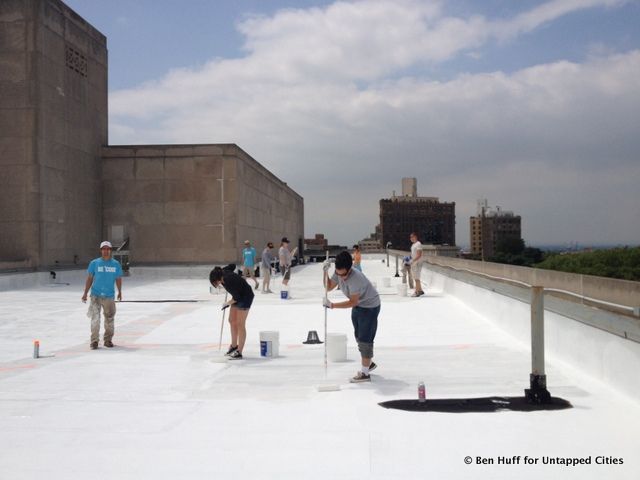
There are numerous interventions possible, including green roofs, but white roofs are by far the most cost effective. PlaNYC included white roof as part of the city’s strategy to reduce greenhouse gas emissions 30% by 2030. NYC °CoolRoofs uses corporate support and grants to fund small organizations that purchase the supplies needed. In a retrograde as simple as this, all that is required are paint brushes, rollers, buckets, plastic bags, paint, and of course volunteers. Under the umbrella of the Department of Buildings, NYC °CoolRoofs works behind the scenes to identify roofs, to ensure buildings are structurally safe to paint, and to get volunteers up to paint them. The organization partners with NYC Service, which helps leverage the labor of over 3,000 volunteers–coating over 2.8 million square feet of roofs white so far. NYC Service is not the only player–the White Roof Project performs education outreach and marketing for white roofs, in addition to staffing volunteer projects.
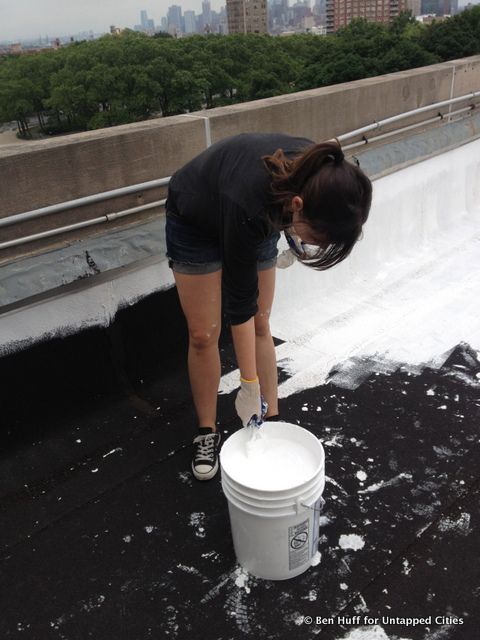
A typical roof in New York City has dark surface. The paint used for whiteroofs is a special acrylic white paint that has latex plastic feel to it. Once a second coat has been applied, an almost shell like membrane forms. Besides cooling the roof, and ultimately the building below, the specialty latex paint also helps improve the roof by making it more water and heat resistant. A study by Columbia’s Center For Climate Research found that white roofs were on average 43 degrees cooler than the unpainted black section. This helps reduce heat expansion on the roofing material and ultimately slow down degradation. Together these benefits help extend the life of the building’s roof by 10 years if properly maintained. Obvious targets for NYC °CoolRoofs and White Roof Project are civic, institutional and nonprofit buildings.
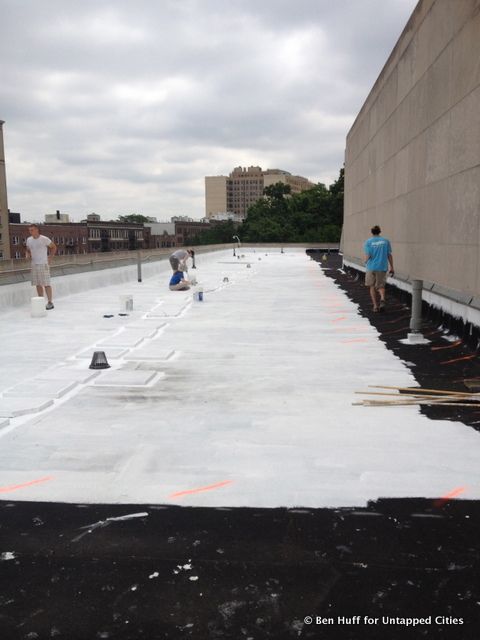
Whereas the private market may be able to leverage its own capital to retrofit their roofs, the city’s own building stock greatly benefits from outside funding and volunteers. By starting with its own buildings, the city has shown that it’s serious about reducing greenhouse gas emissions. Beyond the results, success also lies in how many different stakeholders have come together to cooperate on the project. A roof project I worked on was sponsored by the Manhattan Downtown Democrats and White Roof Project, and comprised the entire block between 2nd and 3rd Avenue on East 4th Street. We had groups of people painting each roof on the block, benefitting Fourth Arts Block (FAB). This summer I coated roof a New York City Housing Authority building also on East 4th that was sponsored by Sony.

But my favorite coating I did this summer was on Brooklyn Public Library’s main branch in Prospect Heights sponsored by Consolidated Edison. At the individual level, each roof brings in volunteers of all types. I’ve met and painted with a former marine looking to start a green roof company, interns from various city agencies, a school teacher from Chinatown, a reporter, an architect taking time off working on a Chinese Disneyland project and a man out of work who was just looking to do some good with his time. What connects all these individuals (besides being on a roof together) is a shared responsibility that climate change needs to be addressed. Beyond the work, each person can walk away with new connections.
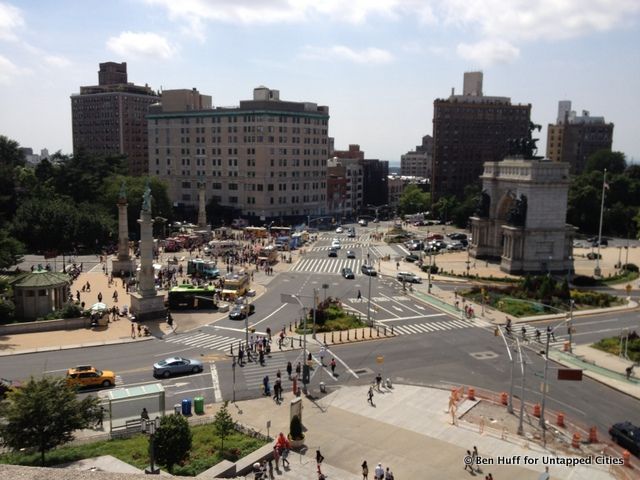
The biggest perk, as the pictures show, is the wonderful view of the city provided by these roofs. From the Brooklyn Public Library we were able to see the magnificent Beaux Arts Grand Army Plaza as it was envisioned by its designers. On East 4th Street, even on just the 6th floor, we had amazing views of the both the midtown and downtown skylines, with the Empire State majestically showing the way north, the unfinished but imposing One World Trade Center to the south. Although the work is unpaid, the backdrop for the day is better than most corner offices in the city, and the fresh air from a breeze much sweeter than any air conditioner.
Just as a precaution before I left, I tested the paints ability to reflect heat myself. I found a spot that was still black next to a newly painted white section, and put a hand on each. Without even thinking of the numbers I could swear it felt like a 50 degrees difference. I had all the proof I needed that this work was certainly not for naught. The experience has left me with a sense of pride every time I walk past the Brooklyn Public Library now.
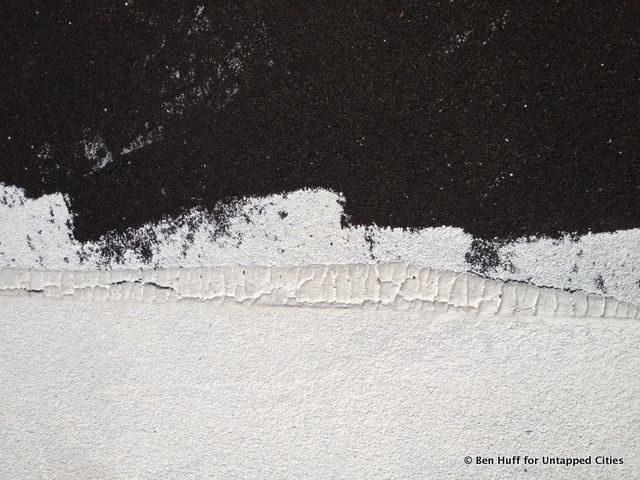
I hope the conversation that is started from this goes beyond just how we can paint more roofs white, but how can we reuse them. Getting on the roof and painting it white is just the first step, from there once we have seen these spaces can better serve the residents or workers who use them. The roof of Brooklyn Public Library is immense and located next to wonderful parks. What if we could turn portions of this into a green roof, and host gardening classes for young kids. Could a green roof inspire children to learn about botany or get involved in environmental work?
By the end of the summer, New York City may see its 3 millionth square foot coated, with 3 more million to go. Achieving 6 million square feet of white roof could reduce the city’s carbon footprint by 6,000 tons of C02. For those that are interested in volunteering, contact NYC °CoolRoofs or the White Roof Project. In our next article, Untapped New York will explore green roofs, and the movement to create green, livable spaces rather than just reflective ones.
Subscribe to our newsletter